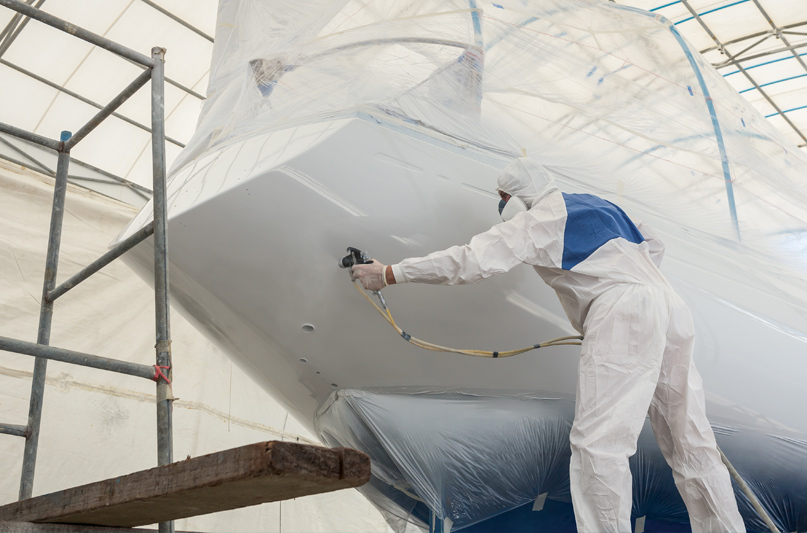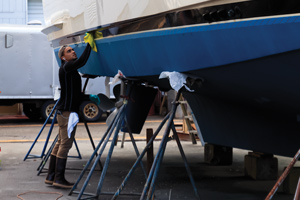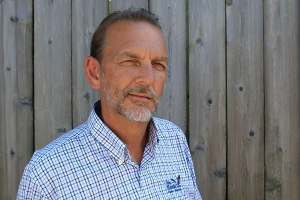
“Every time I paint a portrait I lose a friend.”
—John Singer Sargent, from Bentley and Esar, Treasury of Humorous Quotations
When it comes to painting a boat, owners usually have the below-water topics on their minds. This makes some degree of sense, for we’re usually preparing for a bottom paint job every year or two (or three), and Washington boaters have been reading about the new copper-based regulations. However, the topside of the boat is what you and The People will be looking at on a regular basis. As they say in the biz, do you want to just show up, or to arrive?
Moving above the waterline shifts the emphasis of the paint jobs from the purely utilitarian, anti-fouling focus of the bottom paints and introduces artistic and aesthetic value into the equation. Above the waterline is where truly talented paint applicators can strut their stuff, often for top dollar. The do it yourselfers (DIYers) will have their work cut out for them above the water, with deck hardware obstacles and more demanding preparation regimens being just a few of the hurdles to navigate. Small imperfections, barely perceptible to the casual observer, may drive the owner crazy for years.
For some insight into the world of topside paints, we turn to local Sea Hawk Paints representative Tony Bulpin. Between the buzz around low VOC (volatile organic compounds) paints, the many different kinds from classic gelcoat to two-part polyurethane, and the value of responsive support from the manufacturer, there is plenty to talk about.
NWY: So you’ve been Seattle-based for your whole career. Is there anything unique about the Seattle boat paint scene?
In my opinion, some of the finest painters in the country are located right here in the Pacific Northwest. After spending time in places all over the country, including boating hubs in Florida, the simple truth is that some of the finest painters and contractors are right in our own backyards.
NWY: What are two-part polyurethanes? What are the pros and cons vs. some of the more traditional options like gelcoat?
My thoughts on two-part polyurethanes is that they will withstand the rigors of the marine environment the best. They have resistance to solvents, too. They are abrasion resistant and are hard and tough. They will maintain their gloss for longer than a traditional gelcoat finish that will break down in the ultraviolet light. Two-part polyurethanes are less vulnerable to sun damage. They are more complicated to apply and generally more expensive than simpler systems, but they offer some clear benefits.
NWY: Do you see more two-part polyurethanes these days, or is it still a gelcoat world?
It’s still a gelcoat world, especially from the manufacturing aspect. But I’ve noticed that the larger boats tend to convert to two-part polyurethanes as the years go on. As far as options go, you’ve got two-part polyurethanes and acrylic urethanes, gelcoat, and single-part enamels.
In my opinion, the single-part enamel doesn’t hold up to more modern two-part polyurethanes or acrylic urethanes. However, the polyurethanes require much more preparation and have a more labor intensive, complex application system. A DIYer can do polyurethane, but they need to be willing to learn the preparation tricks.
NWY: Preparation for the topside coating seems to be a vital part of the process?
You’re essentially applying layers of compounds between steps of sanding. Once the sanding of the old coating has been done with the recommended grit, identify what primers are needed for your chosen system. Often, you’ll start with an epoxy primer, then perhaps a high build primer, and then maybe a fairing compound. Then comes the topcoat. The steps for preparation is dependent on the kind of boat you’re painting. Fiberglass uses epoxy primers, steel and aluminum will use metal primers followed by epoxy primers, etc. Make sure to use recommendations from the manufacturer.
There’s a step between each application of sanding with recommended grit, then applying the next primer or fairing compound, followed by sanding with recommended grit, then the next coating, etc. Every manufacturer has a specific system in place that they recommend, and it’s important to be keyed into the established method.
NWY: When it comes to personal protection, is it as important with topside jobs as with bottom jobs?
It’s more important to use personal protection with topside jobs than bottom paint jobs. Personal protection is always important with paint jobs, but because of the isocyanates that go into some of the topside finishes, it’s absolutely vital you do not shortcut personal protection. Personal protection is not just a respirator, it’s a face mask with respirator and full skin protection.
NWY: The copper bottom paint regulations for Washington state is on a lot of boaters’ minds. Are there similar regulations looming for topside paints as well?
There are certain air quality districts in the USA that ban some common topside coating products. Volatile organic compounds (VOCs) are often regulated locally, and certain products are not able to be used. Certain paint companies are producing products with lower VOC content with success.
I’m not a chemist, so I can’t get into the nitty gritty of why VOCs are a concern. But basically, VOCs get into the atmosphere and it’s bad for the environment. VOCs have been heavily regulated in the automotive industry for a long time, and now more regulations on VOCs are carrying over into the maritime industry, including anti-fouling paints. Washington doesn’t have specific maritime VOC regulations yet.
Sea Hawk has already developed products that are low VOC to comply with federal and certain strict districts’ air quality standards. VOCs and the different solvents being used to get to lower VOC products could be a whole other article. But, make no mistake, companies like the one I work for pay attention to VOC compliance, and we’re always working to make our products more VOC compliant.
NWY: We talked a little about glossy finishes. You get that topside paint on, and the next layer is the gloss?
Gloss is generally incorporated into polyurethanes as well as acrylic urethanes. There are new products on the market that are incorporating color with gloss and the like. Again, refer to the manufacturer. Manufacturers will sometimes say that their paint with gloss finish incorporated is as good as the competitors’ gloss finish. The products are getting better with systems that may include clear coats over color. Manufacturers differ; some recommended multiple layers of clear coat and others say you don’t need them.
NWY: Is there a movement to incorporate as many layers into single topside coatings, or are manufacturers not shy about increasing the number of layers of product needed?
They are not shy about adding layers of different products. The more product you put on, the more labor it takes to apply. It can double the cost of the paint job depending on colors, gloss, layers, etc. There are differences between the painters themselves, too.
A painter once said to me you can either show up to the marina or arrive at the marina. Some painters take what they do as if the boat is their calling card, a true piece of art in the marina. When you meet one of boat owners who used a painter like that, they know their painter intimately. It’s a relationship that’s ongoing, you get your “paint guy.” The biggest thing is that there’s no short cuts with these products, you pay for it now or later.
NWY: Are there things you can do to extend the lifespan of a paint job?
Keep it clean, that’s the main one. I’ve always recommended a good boat soap, nothing special. Depending on acrylic urethane or polyurethane, there are some companies that recommended washes and waxes for their finishes. I’d consult with each one of the manufacturers and pay attention to what their care and maintenance for their finishes are.
NWY: Is there an easy way to ballpark the cost of a topside paint job?
Not really, there’s no per-foot formula. Consult with your manufacturer professional. An applicator will look at your boat and give you an estimate, but once they get into a project, they may get into something they did not see that will throw that estimate out the window. Factors like how the fiberglass was laid up or how the pervious gelcoat was applied can really increase the labor of the job. When comparing estimates between different painters, make sure you’re talking apples to apples. Also, be sure to differentiate between an estimate and a firm bid for the job as well.
NWY: It seems like, because each of these coatings has their own unique composition, consulting the manufacturer for recommendations is always a good go-to move when you have a question?
Yes, and that’s what makes us reps so important. The products on the market that are successful have good representation that works with the professional applicators to make sure they are applying the products per the specifications, kind of like how we do it with the certified applicator job. These manufacturer application systems and recommendations are the fruit of a lot of behind-the-scenes labor by the company, and I recommend taking advantage of that as a customer.
NWY: Sea Hawk has a warranty if you use one of their applicators, correct?
What we do is certify yards, and that puts our applicators on our website so when customers get on our website and look for an applicator in our area, it pulls up the certified applicators who have been trained and certified by Sea Hawk.
NWY: Any final thoughts?
Consult with your boatyard. Usually your boatyard will steer you in the right direction with their in-house paint crew or a local crew. If you call the boatyards in your area, I think you’ll find most of them will give you names of certain experts in the area. Those network connections are valuable, and some of the painters in the Northwest have been doing it for over 20 years.

